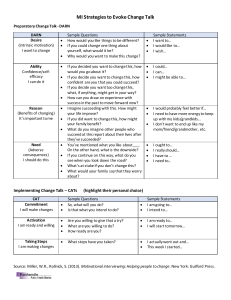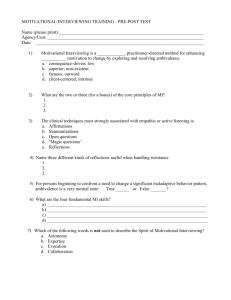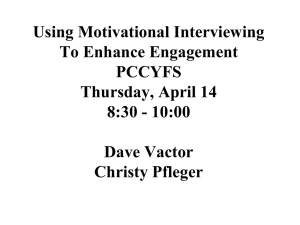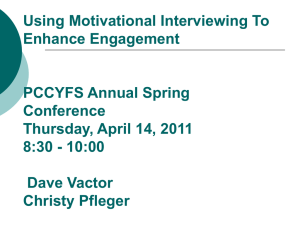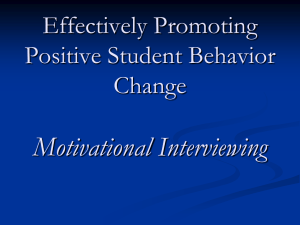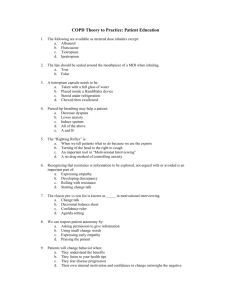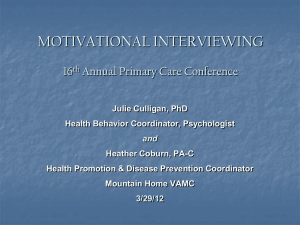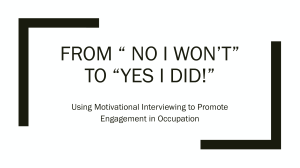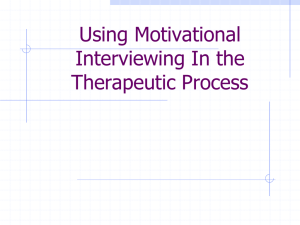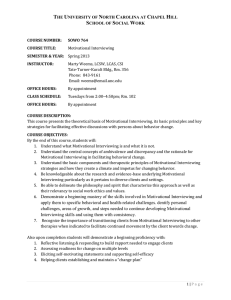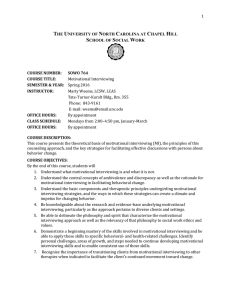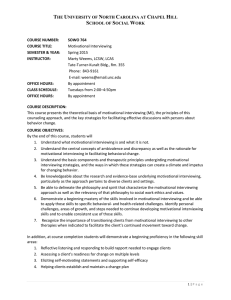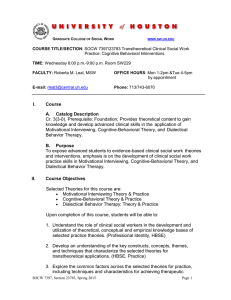Motivational Interviewing for Public Health
advertisement
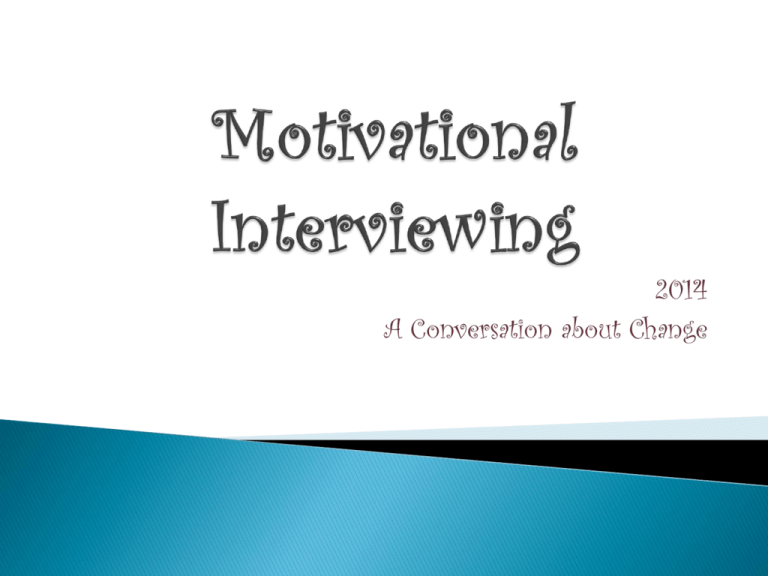
2014 A Conversation about Change Presentation Objectives: • • • • Define MI What is the spirit of MI Describe the components of change Identify OARS and how it is used in MI Rollnick and Miller describe MI as “a directive, client centered counseling style for eliciting behavior change by helping clients to explore and resolve ambivalence.” Rollnick, Miller, & Butler, Motivational Interviewing in Health Care, 2008. Individuals change voluntarily when they…. Become interested in or concerned about the need for change Become convinced that the change is in their best interest or will benefit them more than cost them Organize a plan of action that they are committed to implementing Take the actions that are necessary to make the change and sustain the change. Jeremy Evendon, MISSA, LISW-S, SAMHA, HRSA webinar. www.intergration.samhsa.gov What and Why would I want to change????? The Spirit of MI is captured in four terms: •Partnership – Collaborative and cooperative partnership between the client and clinician •Acceptance – Worth, Empathy, and Autonomy To recognize and honor this autonomy is also a key element in facilitating health behavior change. •Compassion- It’s NOT sympathy. It’s focusing on the best interest of our clients, understanding their concerns. •Evocation – An evocative spirit implies that the majority of the answers are in the client, not in us. EACH PERSON HAS PERSONAL GOALS, VALUES, ASPIRATIONS, AND DREAMS. Part of the art of MI is connecting health behavior change with what your patients care about, with their own values and concerns. Are we committed to hearing the client’s voice, honoring the clients self-direction, capacity, strength, and experience? “Motivational Interviewing: Helping People Change,” Third Edition, The Guilford Press:2013. Robert Rhode, 2013 rrhode@u.arizona.edu 4 Guiding Principles of MI R: Resist the Righting Reflex Arguing decreases the likelihood of change. “But….” U: Understand and explore the patients’ own motivations What would be their reason for change? How would they do it? L: Listen with empathy They may likely give you the answer to their problem by just talking it through. VENA goals E: Empower the patient, encouraging hope and optimism. Help show them that anything is possible. If it is their idea, they are more likely to do something about it. People believe more what they say than what they hear. Rollnick, Miller, & Butler, Motivational Interviewing in Health Care, 2008. Components of Change RESISTANCE AMBIVALENCE MOTIVATION RESISTANCE 6 things you can do to make your life more difficult: 1.Question/Answer 2.Argue for Change 3.Be the Expert 4.Label 5.Premature Focus 6.Blame/Shame Jeremy Evendon, MISSA, LISW-S, SAMHA, HRSA webinar. www.intergration.samhsa.gov AMBIVALENCE I need to lose some weight, BUT I don’t know what to eat. I want to exercise, BUT I get bored. I know she needs less juice, BUT I can’t get her to drink water. I know I should always use condoms, BUT he doesn’t like them. DANCR Steps: •Desire to change – Clients might include a reference to enjoying, liking, disliking, wanting, or not wanting to do the target behavior. I want to… I would like to… I wish… •Ability to change – Clients might describe being able, unable, capable, or incapable of doing the target behavior; or clients might describe that something is possible or impossible to do. I could… I can… I might be able to… •Need to change – Clients might reference their sense of obligation that they should do the target behavior, or that it is unfair or unjust that they are being asked to do something. I ought to… I really should… I have to… DANCR Steps: •Commitment to change – When clients talk about what they will or won’t be going in the future. I will… I am going to… •Reasons to change – When the client statements would answer the questions, “Why are you doing _______?” or “Why aren’t you doing_______?” the client is describing his or her reasons. •Steps that could lead to the health promoting behavior – It might be easier to remember this as “starts” or “starting steps” because it is when the client describes what he or she has already done. It is past tense. Clients might describe what they have already done that might get them closer or hinder them from a goal. Robert Rhode, 2013 rrhode@u.arizona.edu MOTIVATION 3 Communication Styles Following Directing Guiding 3 Core Communication Skills Asking Informing Listening 50 40 30 Informing 20 Asking Listening 10 0 Directing Guiding Following OARS: Open Ended Questions Affirmation Reflect feelings and change talk Summarize +Inform or Advise SKILLS: •Open-ended questions about the client’s experience, especially in the change direction. •Affirmations – Comment favorably on a trait, attribute, or strength of the client that would support doing the health promoting behavior •Reflecting or summarizing is a key part of empathy which is central to facilitating change. Reflect and Summarize the change talk in particular. •+ Inform or advise ways to help accomplish their goals (with their permission) Change Talk Preparatory: Desire Ability Reason Need Mobilizing Change Talk: Commitment Activation Taking Steps What might you enjoy about improving your nutrition? How might you be able to arrange some physical activity for you and your child? Why do you think you need to improve your nutrition? What reasons do you have for continuing with your exercises? If you decided to eat less red meat, what might you do today or tomorrow? Steven P. Wells, Ph.D. (LCSW) AFFIRMATION: •“You’re the kind of person that puts a lot of thought into something.” •“You’re contributing some really important ideas here.” •“You’re very dedicated to feeding your baby a healthy diet.” REFLECT: Simple: These stay close to the topic at hand •Repetition – Be careful not to become the parrot. •Rephrase Complex: Makes a guess •Paraphrase: “continuing the paragraph” •Reflection of feelings SUMMARIZE: what he or she said about – •Desire to change •His or her ability to change •Need to change •Reason to change. •Then ask, “What do you think you will do?”, and just listen. Join up, partner with…… Accept the client, empathize Be curious, what do they know? Be compassionate, dedicated “Given a choice between changing and proving that it is not necessary, most people get busy with the proof.” -John Galbraith Evenden, MSSA, LISW-S “Engaging People in Discussions About Health-related Changes” The Center for Evidence-Based Practices at Case Western Reserve University. SAMHSA webinar, August, 2012 www.integration.samhsa.gov Miller, W. & Rollnick, S., “Motivational Interviewing: Preparing People for Change”. 2nd Edition, Guilford Press, NY, 2002. Miller, W. & Rollnick, S., “Motivational Interviewing: Preparing People for Change”. 3rd edition, Guilford Press, NY, 2012. Rhode, Robert, Assistant Professor, University of Arizona. “Motivation interviewing: Enhancing your outcomes by quitting your job, getting on the bus, and going fishing.” May 2013, Denver, CO Rollnick, S., Mason, P., & Butler, C., “Motivational Interviewing in Health Care: Helping Patients Change Behavior” Guilford Press, NY, 2008. Wells, Steven P., Ph.D. Oklahoma Leadership Education in Neurodevelopmental and Related Disabilities (LEND), College of Medicine, University of Oklahoma Health Science Center. “Partners in Progress—Strengthening Oklahoma Families” Oct. 2013, Norman, OK.
